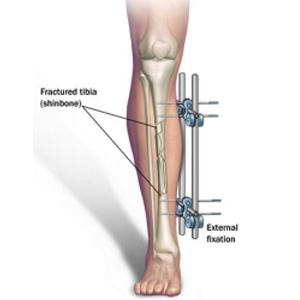Limb Lengthening Surgery
While lengthening or correcting a deformed limb, the principle that is based on is distraction osteogenesis. During this process, a bone that has been cut surgically is gradually distracted (pulled apart), leading to a new bone formation (osteogenesis) at the spot that has been lengthened. This technique is most frequently used to correct limb length discrepancies (LLDs) in both adults and children which may arise either due to birth defects, diseases or injuries. This method is also used to correct deformities in other joints, hip correction and treating complex problems concerning scar tissue that limits normal limb function and movement. Highly trained orthopaedic surgeons have an extensive knowledge and experience in correcting LLDs by utilizing the full range of techniques that include the Ilizarov and Taylor Spatial Frames and intramedullary nailing techniques.
Conditions Treated
External fixation can be used to correct limb length discrepancies and deformities with different causes such as:
Trauma: Growth plate fractures, malunion (where the bones heal crooked), nonunion (where bone heals incompletely), shortening and deformity due to bone loss.
Congenital limb length discrepancies: These conditions are associated with many birth defects and deformities including short femur, fibular hemimela, pseudoarthrosis and hemiatrophy.
Short stature:This could include achondroplasia and other skeletal dysplasias and constitutional short stature. External fixators are effective in treating limb length discrepancies linked to dwarfism. Treatment may be appropriate in some cases in order to allow the patient to function more independently.
Infection: This could involve the bone (Osteomyelitis) and joint (septic arthritis). Treatment of bone infection often requires removal of bone segments which may result in angular deformities and limb length discrepancies.
Developmental causes: These are related to the slowing of growth and limb deformities caused by illness such as Blount’s Disease, which typically affects the bone development of overweight toddlers and adolescents.
Pediatric hip disorders: External fixators are also used in the treatment of pediatric hip disorders such as Developmental Coxa Vara (DCV), Perthes disease and Slipped Capital Femoral Epiphyses (SCFE).
Joint stiffness: This could occur following injury or infection, Other causes can sometimes be addressed by controlled joint distraction (arthrodiatasis), with the use of external fixators.
Soft tissue scarring: Burns and multiple surgeries for club foot correction can be addressed with gradual distraction techniques.


